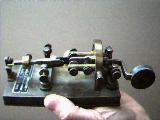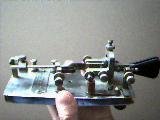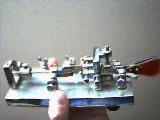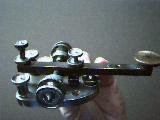Lytle Triplex, Wilcox, and Xograph Keys


The first rotatable semiautomatic bug was introduced in 1924 and was called the Lytle Triplex. It was intended to be used left- handed, right-handed or as a straight key. Manufactured by the Precision Thermometer and Instrument Company of Philadelphia, Pennsylvania, it sits on a relatively small base and has an oddly shaped damper.

"In the 1920's, Rolph Brown of the Canadian Pacific Telegraph Company in
Toronto brought out a bug which he called the "Xograph." This was a neat
small bug with a black or nickeled base."
--History of the Canadian Key by Murray Willer
Click here to see an explanation of how the bell works!

"Another Canadian, Fred Wilcox of the Canadian National Telegraph
Company of Toronto, was an excellent machinist. He even had a machine
shop at home and, in the 1920's and 30's, built a number of bugs for his
telegraph friends. Fred did not use standard tooling and his various bugs
show slight differences in detail. However, all had heavy nickeled steel
or brass bases."
--History of the Canadian Key by Murray Willer

This key may be a bit of a hybrid, as the lever arm doesn't look quite right, but the base and hardware of this key make it likely a key from the Canadian Northwest Railroad. The hardware is quite distinctive, with large nippled screwheads and heavy construction. This key was obtained at the Wellington, Ohio hamfest, a relatively short distance from the Canadian border.

A cell is an apparatus for producing a current of electricity by chemical action. A battery consists of a number of cells joined together. A cell usually consists of two different conductors immersed in a solution of acid. Chemical action is set up by the acid attacking the zinc in this case, and the energy liberated by the dissolving of the zinc appears in the form of a current of electricity. Hold your mouse down on the cell to connect the two electrodes and start the flow of electrons from the submerged zinc to the submerged carbon and back through the connector! The current will continue as long as there is any chemical action going on, until the zinc plate is all dissolved, or the acid all neutralized by its solution. Adapted from "The Elementary Principles of Wireless Telegraphy" by R.D. Bangay.

 Back to the Index
Back to the Index
 On to more keys!
On to more keys!